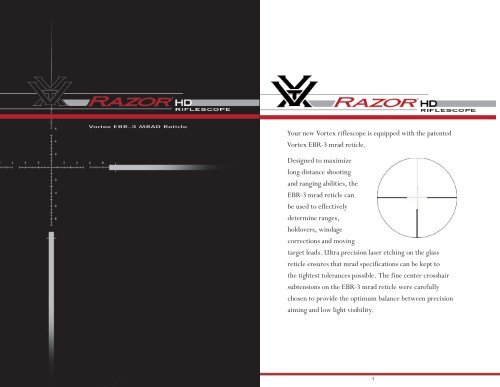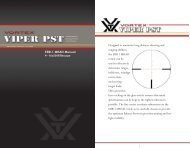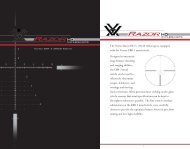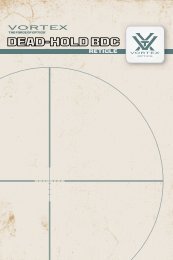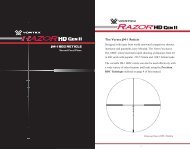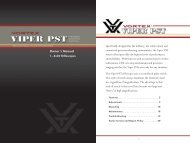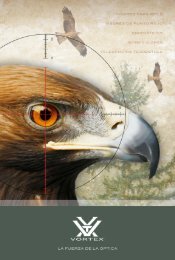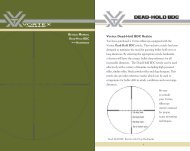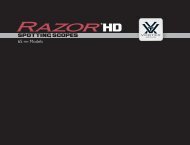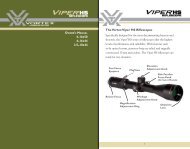Vortex ebr-3 reticle manual - EuroOptic.com
Vortex ebr-3 reticle manual - EuroOptic.com
Vortex ebr-3 reticle manual - EuroOptic.com
Create successful ePaper yourself
Turn your PDF publications into a flip-book with our unique Google optimized e-Paper software.
<strong>Vortex</strong> EBR-3 MRAD Reticle<br />
Your new <strong>Vortex</strong> riflescope is equipped with the patented<br />
<strong>Vortex</strong> EBR-3 mrad <strong>reticle</strong>.<br />
Designed to maximize<br />
long distance shooting<br />
and ranging abilities, the<br />
EBR-3 mrad <strong>reticle</strong> can<br />
be used to effectively<br />
determine ranges,<br />
holdovers, windage<br />
corrections and moving<br />
target leads. Ultra precision laser etching on the glass<br />
<strong>reticle</strong> ensures that mrad specifications can be kept to<br />
the tightest tolerances possible. The fine center crosshair<br />
subtensions on the EBR-3 mrad <strong>reticle</strong> were carefully<br />
chosen to provide the optimum balance between precision<br />
aiming and low light visibility.<br />
1
MRAD Subtensions<br />
The EBR-3 mrad <strong>reticle</strong> is based on the milliradian<br />
(or mrad for short), a form of angular measurement.<br />
This measurement is similar in concept to a degree<br />
although much finer. A degree is 1/360th of a circle; a<br />
milliradian is 1/6283th of a circle.<br />
Most shooters are familiar with the minute-of-angle<br />
(MOA) system <strong>com</strong>monly used in hunting riflescopes.<br />
MOA measurements are based on degrees and minutes:<br />
360 degrees in a circle, 60 minutes in a degree for a<br />
total of 21,600 minutes. When <strong>com</strong>paring MOAs and<br />
mrads, 3.44 MOAs is equal to 1 mrad. These angular<br />
measurements are used for ranging and to correct for<br />
bullet trajectory drop in riflescopes.<br />
Subtensions<br />
.1 mrad subtension marks<br />
.5 mrad subtension marks<br />
Fine Crosshair thickness<br />
subtends .06 mrads<br />
Numbers indicate mrads<br />
Outer Fine Crosshair thickness<br />
subtends .03 mrads<br />
Both mrad and MOA measurements are effective for ranging<br />
and bullet trajectory drop <strong>com</strong>pensation in <strong>reticle</strong> designs.<br />
However, the mrad method used in the EBR-3 mrad has<br />
some important advantages over an MOA method. The<br />
primary benefit is that once learned, it is much simpler<br />
and faster to use. The mrad system will also be very easy<br />
for shooters familiar with the metric system and for those<br />
shooters with previous training in using mil dot <strong>reticle</strong>s.<br />
Heavy Crosshair thickness<br />
subtends .8 mrads<br />
When used in a first focal plane <strong>Vortex</strong> Razor HD riflescope,<br />
the EBR-3 <strong>reticle</strong> mrad subtensions listed in this <strong>manual</strong> are<br />
valid at all magnification levels. This means the shooter can use<br />
the magnification level most appropriate for the situation and<br />
still have effective holdover and windage reference marks.<br />
2 3
Ranging<br />
The EBR-3 mrad <strong>reticle</strong> is very effective for ranging using<br />
simple formulas.<br />
Mrad Ranging Formulas<br />
Accurate measuring will depend on a very steady hold. The<br />
rifle should be solidly braced using a rest, bipod or sling<br />
when measuring. Once you have an accurate mrad reading,<br />
use the any of the ranging formulas to calculate distance.<br />
Target Size (Yards) x 1000<br />
mrads Read<br />
=<br />
Range (Yards)<br />
Example<br />
Target Size (Meters) x 1000<br />
mrads Read<br />
=<br />
Range (Meters)<br />
Target Size (Inches) x 27.8<br />
mrads Read<br />
=<br />
Range (yards)<br />
To use these formulas, it will be necessary to know the<br />
measured size of the target or a nearby object. Using either<br />
the vertical or horizontal mrad scale, place the <strong>reticle</strong> on the<br />
target of known measurement and read the number of mrads<br />
spanned. Maximum accuracy in ranging will be obtained<br />
by calculating exact mrad measurements—mrads should be<br />
estimated in 1/10s if possible.<br />
To help calculate 1/10s of mrads, the EBR-3 mrad <strong>reticle</strong> uses<br />
.5 mrad graduations on the inner portion of the crosshair<br />
and .1 mrad graduations on the fine outer scale. The inner<br />
crosshair line thickness subtends .06 mrads and the coarse<br />
outer crosshairs subtend .8 mrads. Fine outer scale lines<br />
subtend .03 mrads.<br />
Ranging a target stand that is one meter tall at 2 mrads to get 500 meters.<br />
1 x 1000<br />
= 500 Meters<br />
2 mrads<br />
4 5
Elevation Holdovers<br />
Once the distance has been calculated using the EBR-3<br />
or a laser rangefinder, the EBR-3 can be used for rapid<br />
holdover correction for the bullet drop of the weapon<br />
system being used. To get the most benefit out of the<br />
riflescope equipped with the EBR-3 <strong>reticle</strong>, <strong>Vortex</strong><br />
Optics highly re<strong>com</strong>mends shooters learn their bullet<br />
drop numbers and windage/lead corrections in mrads<br />
rather than inches or MOAs. Remember that 1 mrad<br />
equals 3.44 MOA or 3.6 inches per 100 yards.<br />
Since the EBR-3 <strong>reticle</strong> is marked in mrads, it is an easy<br />
job to quickly select the correct drop reference line<br />
once the shooter knows the bullet drops and windage/<br />
lead corrections in mrads. If the shooter prefers to dial<br />
the <strong>com</strong>e ups for bullet drop using the elevation knob,<br />
knowing bullet drops in mrads will allow for much<br />
faster adjustments because the mrads can be quickly<br />
read on the elevation knob.<br />
Example<br />
7.7 mrad <strong>reticle</strong> holdover correction for 800-yard shot. No wind.<br />
6 7
Windage and Moving Targets<br />
The EBR-3 <strong>reticle</strong> is highly effective when used for<br />
wind and moving target leads. Using the <strong>reticle</strong> for<br />
effective windage and moving leads will require a<br />
thorough knowledge of your weapon system’s ballistic<br />
performance under varying conditions and experience<br />
in reading wind strengths and target speeds. As in<br />
bullet drops, it is imperative the shooter learn their<br />
particular weapon’s windage/moving target corrections<br />
in mrads rather than inches or MOAs. Always hold the<br />
<strong>reticle</strong> into the wind when correcting for wind drift.<br />
Example<br />
15 mph wind<br />
Full value wind at 90 degrees<br />
Basic windage correction on center crosshair<br />
When dialing elevation <strong>com</strong>e ups, the center<br />
horizontal crosshair will be used for windage or<br />
moving target leads. Mrad marks on the horizontal<br />
crosshair are graduated in .5 mrad increments, with<br />
.2 mrad marks in outermost sections.<br />
2.6 mrad <strong>reticle</strong> correction for 15 mph wind at 700 yards. Elevation already<br />
dialed into turret.<br />
8 9
Basic moving lead correction<br />
When estimating moving target leads, the mrad<br />
marks on the center horizontal crosshair can be used.<br />
Estimating moving leads will require knowing yardage<br />
distance, wind speed, moving target speed and total<br />
bullet flight times including rifle lock time. Bullet flight<br />
times can be roughly calculated based on fps velocities<br />
or a ballistic calculator.<br />
Example<br />
Note: Correctly estimating moving leads is very diffi cult and<br />
requires considerable practice and knowledge beyond the scope of<br />
this <strong>manual</strong>.<br />
Moving Direction<br />
2.74 mrad <strong>reticle</strong> correction for a target moving 3 mph at a distance of<br />
800 yards. No wind. Total bullet time of fl ight from moment of trigger<br />
pull is 1.5 seconds during which a target travels 6.6 feet. Elevation<br />
already dialed into turret.<br />
10 11
<strong>Vortex</strong> Service and Repair Policy<br />
vortexoptics.<strong>com</strong><br />
Unconditional Lifetime Warranty<br />
<strong>Vortex</strong> Optics wants you to shoot<br />
and use your Razor HD riflescope<br />
under any conditions with<br />
<strong>com</strong>plete confidence—that’s why<br />
our warranty is straightforward<br />
and simple:<br />
• Fully transferable<br />
Unconditional Lifetime<br />
Warranty<br />
• No warranty card needed<br />
• No receipt needed<br />
Rest assured, if this riflescope should ever require repair, all<br />
you need to do is contact <strong>Vortex</strong> for absolutely free service.<br />
Call 800-426-0048 or e-mail service@vortexoptics.<strong>com</strong>.<br />
<strong>Vortex</strong> Optics<br />
2120 West Greenview Drive<br />
Middleton, Wisconsin 53562<br />
USA<br />
Patent Pending<br />
Dual Use for Shooting Tactical / Hunting<br />
12 13


